Today I’m going to show you how to find the best Airbnb market for your next investment.
Our goal is a market that can consistently produce >15% cash-on-cash ROI properties.
And you can do this all from your computer, right now.
How do we find the best cities for Airbnb investing for our members?
With the Market Target Formula.
And I’m going to show you how. Step-by-step.
Let’s get started.
1. Make a simple sheet.
Throughout this, we will be collecting a lot of information. And we want to keep the information organized.
Any spreadsheet will do – Google Sheets or Excel. But a digital spreadsheet is important because you’ll be getting information you will need to copy and paste.
We’ll be putting information on here like regulation snippets, links to regulation documents, attractions… all types of links.
If you’re a “paper person” I’m sure you could write these things down instead. But you’ll need a way to keep track of the links you find. For example, a well organized bookmark system from your browser to reference them.
It can be tricky to find some of these things, and you don’t want to lose them.
The columns you can add: Town, # listings, Home price ranges, Regulation links, Regulation snippets, Taxes, Reliance, Market type, Draws, Seasonality, Fly/Drive, Worst, Expected, Notes, Verdict

2. Create a list of 3-5 towns or areas.
This is just the starter list. You don’t have to put a ton of thought into this.
We’ll address each reason why we included each town in the subsequent steps.
But for now, add a handful of cities you want to look up as your potential starting point.

3. Verify number of listings.
Visit a short term rental data provider like AllTheRooms or AirDNA or Rabbu’s free Airbnb calculator and search for the town.
In the results, you should see something like “Active Supply” or “Active Rentals.”
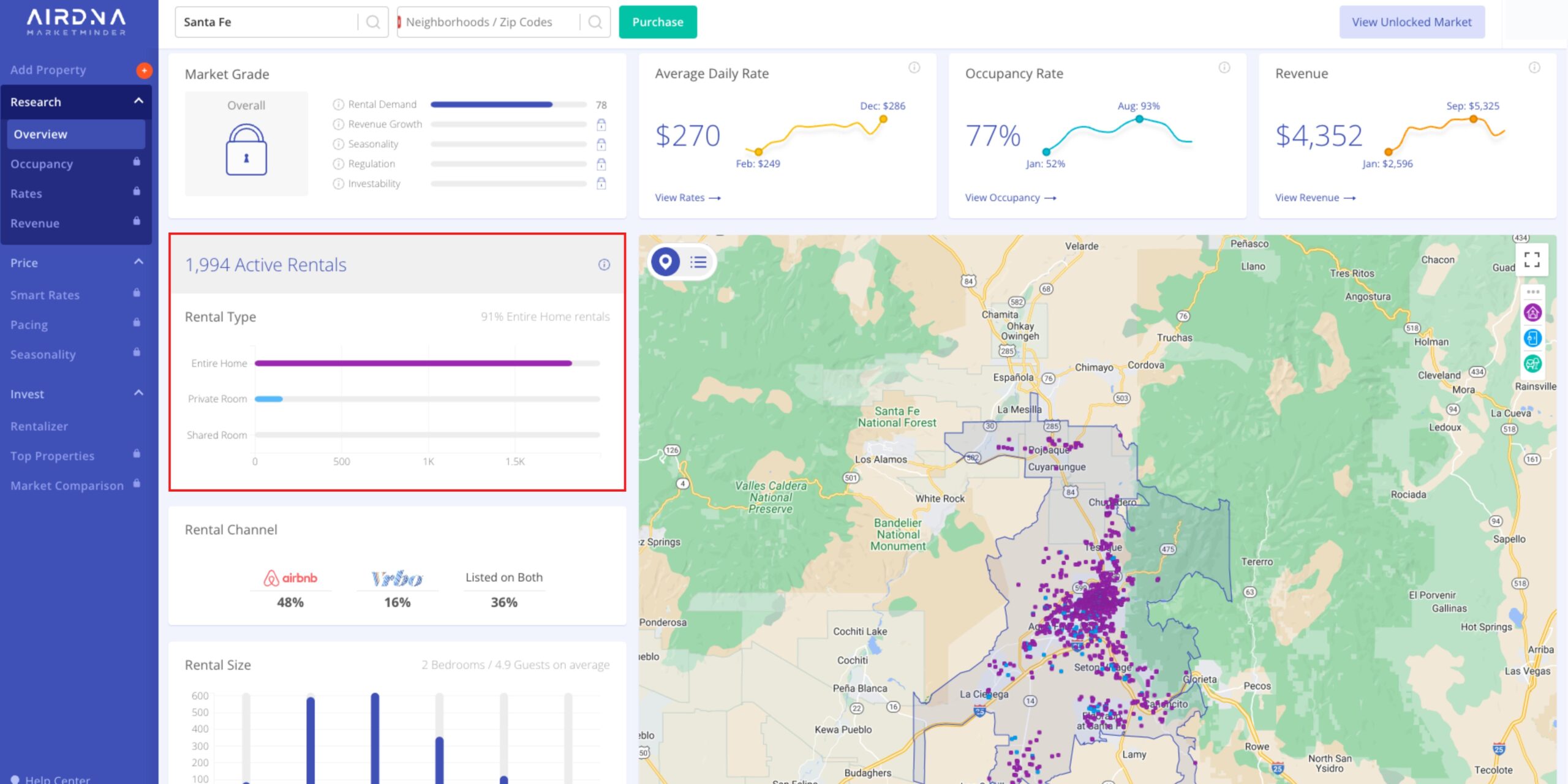
The numbers might be different depending on which data provider you use, because they all draw their boundaries differently.
But the point here is just a quick check to make sure there are a solid number of listings in your market.
We aim for 250 or more active listings for a variety of reasons. Don’t let “competition” scare you – you’re going to crush them whether there’s 300 or 3000.
The pros outweigh the cons.
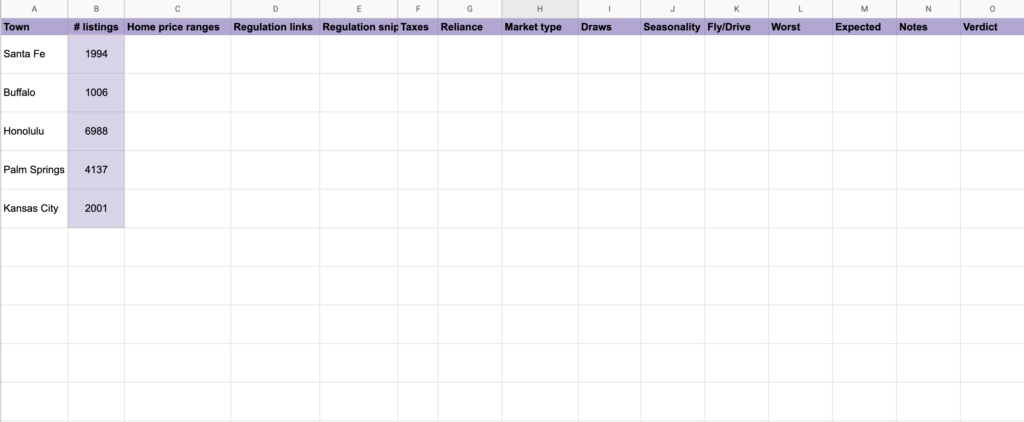
4. Verify home prices are within range.
You could love the idea of owning a short term rental in Maui or Malibu, but your wallet might not.
This is another quick check on Zillow, Realtor, Redfin, etc.
Filter for 1 bedrooms and write down the rough average (just eyeball it) of the homes for sale. Do the same for 2, 3, 4, and 5 bedroom properties in each market.
Note #1: You need to pick the exact bedrooms you want, not a 2+ for example to make sure you’re comparing apples to apples.
Note #2: If you’re looking at what’s for sale right now, understand they can be asking for whatever they want. You might consider choosing to look at what’s been sold, since those are the actual prices people are willing to pay. For sure the “trend” matters, but the actual market matters more and what people want to get for their property.
The goal here is just to get an idea of what it would cost (roughly) to buy a property in this market.
There’s no point continuing too far with things if you can’t afford the properties. If a market you listed is just too expensive, go ahead and cross it off.
Here’s my warning, though: Don’t click on any properties. You’re just wasting time and daydreaming about nothing at this point. This is not the stage to look at properties.
Stay focused!
5. Google search for regulations.
Now we can begin looking for short term rental regulations.
Like the price check, there’s no point even looking at properties or calling anyone unless it’s short term rental friendly in the area.
It’s relatively simple, but not necessarily easy.
Search Google for: “city name” short term rental regulations
(You can also swap the word regulation for laws, bylaws, or rules. You can swap short term rental with vacation rental, vacation home, or tourist home. Different towns call them different things.)
6. Find actual government website and documents.
Now, what you’re looking for is usually the town, county, or municipality website. And specifically, the actual documentation with the regulation written out.
It’s far too risky to move forward with an area based on anecdotal information from an agent or even the person who answers phones at the government building.
You simply must have the actual document in your hand.
If it’s in a link, copy the link to the document(s) into your spreadsheet.
Then, read through it.
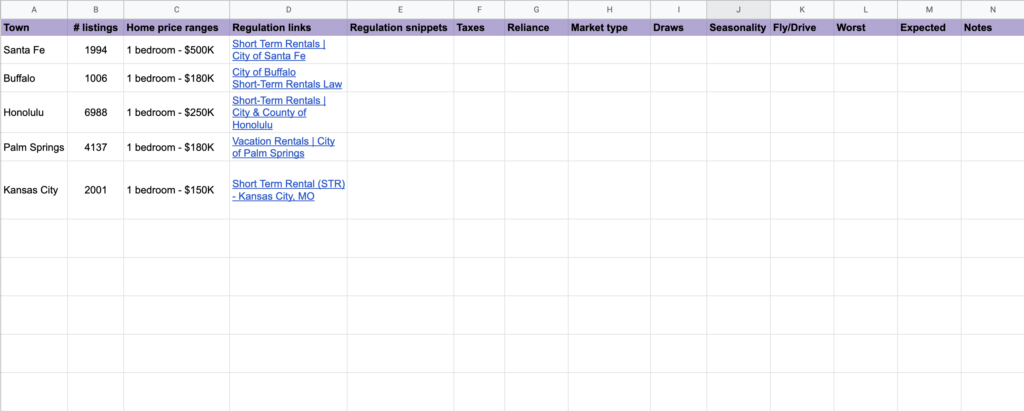
7. Copy relevant bits from regulations.
You’ll want to note anything that specifically mentions short term rental regulations.
Some common regulations you could find:
- Permit limitations (for example, they only grant 1,000 per year)
- Permit steps (they might be open to anyone, but there are exact steps you must follow)
- Occupancy limits by bedroom or house size
- Distance to neighbors
- Night caps (example, limit 180 days you can host guests)
- Outright banning stays under 28, 29, or 30 days
- Owner occupancy (for example, the owner must also live on the property)
- Yearly checks (for example, septic inspections)
- Mandatory signage
- Maximum number of cars in the driveway
- Short term rentals are only allowed in certain zoning
- Or any number of things
If you find something, list it in your sheet.
Again, if you come across something that is against your goals, for example, a ban on any new short term rentals, just cross that town off your list.
8. Verify any local taxes for them.
Sometimes, the regulations you find will also mention specific taxes. Other times you’ll need to hunt down that information separately.
There might be taxes for just the town, or a special tax from the town AND from the state or province.
It’s important to figure that out. It’s not about the money you make, but the money you bring home.
Of course, taxes can seem like a bummer because it’s money leaving your pocket.
But personally I see taxes as a good sign.
Why?
Because the best Airbnb markets are when you and the town are aligned. They want your listing to succeed because they get paid when you do.

9. How much does the town rely on STR?
If you’re investing in a town or city, know that residents will never be okay with short term rentals.
They’ll always hate it.
But you’re going to be a good, respectful host who has a great relationship with the neighbors.
But what about the city itself? We already went over taxes, but is there anything else?
For example, are there a lot of hotel chains in the town? If so, they might not care about Airbnbs housing guests.
If there are no large hotel chains, Airbnb and Vrbo are the ways guests stay in their town.
Next, consider the local businesses. Do they rely on the influx of guests during, say, a high season?
And if short term rentals were to be regulated in this situation? The local business owners would vote against it because they can’t lose that additional income the tourists and vacationers provide.
10. What kind of area is this?
There are three different kinds of markets:
- Vacation: Think families visiting Disney.
- Business: Areas around company headquarters, for instance.
- Tourist: When someone visits to say they went or to take a photo.
Consider the guest. Why are they heading to that area, and can you cater to that type of guest there?
Business travelers and a family of five headed to the beach want very different things.
You can also note on your sheet (in another column) the destination type this is.
For example: beach, mountain, city, college town, lake, national or state parks, theme park, etc.
Likewise, catering to guests to a beach is different than a set of parents visiting their child’s college town.
Then, consider the long term implications of this market and if it’s one you enjoy. If you don’t enjoy the beach, carefully consider investing in a beach town.



11. What draws people there?
Here you’ll note the “amenities” of the town. What events are around here? What is there to do?
Some towns will have their own websites. Check those, as well as popular sites like Tripadvisor. It can be as simple as searching Google for things to do in [the town].
You can skip some of the smaller draw items. Unless a large majority of people would specifically seek it out, you might not list it.
Water World, Zion National Park, or Indy 500? Definitely. Aunt Sue’s Local Antique Store? Probably not.
If you can only find one major thing that would draw people there, consider what happens if it were to go away.
The Indy 500 and Disneyland are not likely to move any time soon. But something like Coachella? Maybe.
And sometimes in certain listing maps, you’ll see that high performing properties are all clustered together.
While this isn’t a good or bad thing, just something to be aware of. If you purchase a property that’s not in this cluster, your returns might not be the same as theirs.
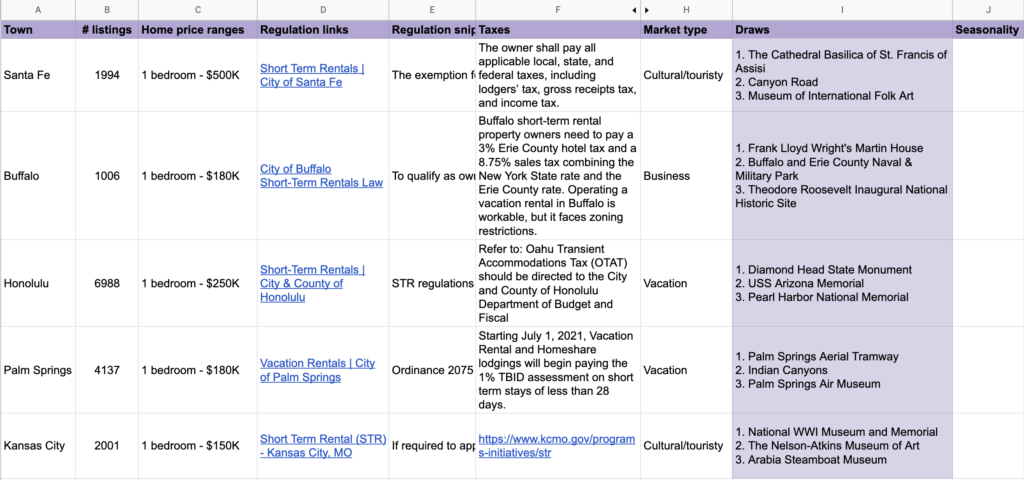
12. How seasonal is it?
You can find this information on AirDNA for example, or purchase the area on AllTheRooms and check ADR and occupancy rate fluctuations.
In AirDNA, the seasonality number is higher if the seasonality is lower (see image below). That is, a higher score means the revenue is more consistent year-round.
In the example below, the AirDNA Seasonality rating is 85. This means it’s more “stable” as far as short term rental income goes. But let’s say Seasonality said 10. In AirDNA-land, that means there are big swings between high and low season.
There are pros and cons to all seasonality types. But it’s something to note.
If it’s highly seasonal, it might be challenging to get bookings during low season. But it provides you an opportunity to stand out and be the one that gets bookings.
If it’s not very seasonal, you get the security of more consistent incomes, especially if you’re used to long term rentals. But this can sometimes mean lower profits overall.
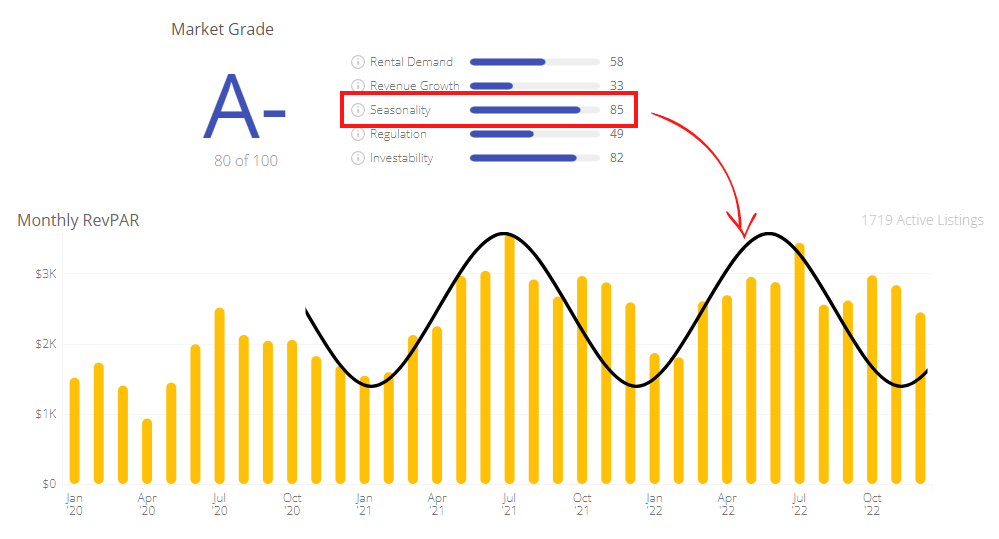
13. Is it close to a main city hub?
Sometimes I talk about the area just outside of large metro areas. In fact, apart from national parks, these areas outside of cities did the best during COVID.
Why?
Because no one could (or they weren’t wanting to) fly to a destination. So they opted for a staycation.
Cities provide a lot of possible guests looking to escape a city that (during the pandemic) had nothing happening.
You don’t have to aim for a market like this, but it’s worth noting. It can be a great backup in the off-chance cities shut down completely again.
Usually, we say the two-hour drive radius around a major city is the starting point for this. Or, if you can pull on multiple large cities within driving distance, that’s great too.
But you can also just use this column to answer the question: Are the guests usually flying into this location or driving?
PriceLabs Market Dashboards are a great tool to see the demand for the most popular amenities in your area. And just because an amenity is rare (like a hot tub) doesn’t mean it’s not a fantastic choice.

14. Town research: Why YOU like it.
This one is (usually) the easiest question to answer.
Like I mentioned earlier, you should carefully consider investing in a beach market if you can’t stand beaches.
Maybe you love mountain biking and the area is well known in mountain biking circles for having great trails.
Maybe you have good memories of the area because your family took you there as a kid.
Or maybe the reason it’s on your list right now is because you hear about it a lot.
Whatever the reason, be honest, and write it down.
15. Get “worst case” revenue numbers.
If you get to this point and you haven’t crossed a town off, you’re serious about the market.
When we look at markets, we need a return on investment. Not many people want the property to at least pay for itself.
For me, that point is in a worst case scenario. I don’t want to have to pay out of pocket, even when things get “bad.”
We’re after the 50th percentile numbers (the median value) for “worst case.”
Now might be a great time to purchase the market you’re looking at. Pick either AllTheRooms or AirDNA and stick to that one so you are comparing apples to apples.
We want to look at total revenue. ADR or occupancy alone won’t help us.
Export the total revenue for the number of bedrooms and occupancies at each point. Again, make sure you export using the same settings for each town.
For example, if you’re filtering for 3 bedrooms, entire house, and holds 6-8 guests, make sure you do that for all markets.
You can also filter for 4 bedrooms and 8-10 guests, and so on.
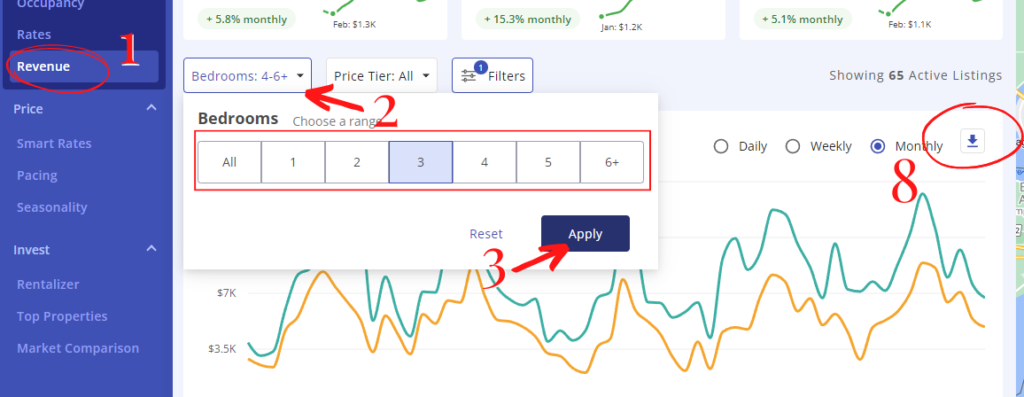
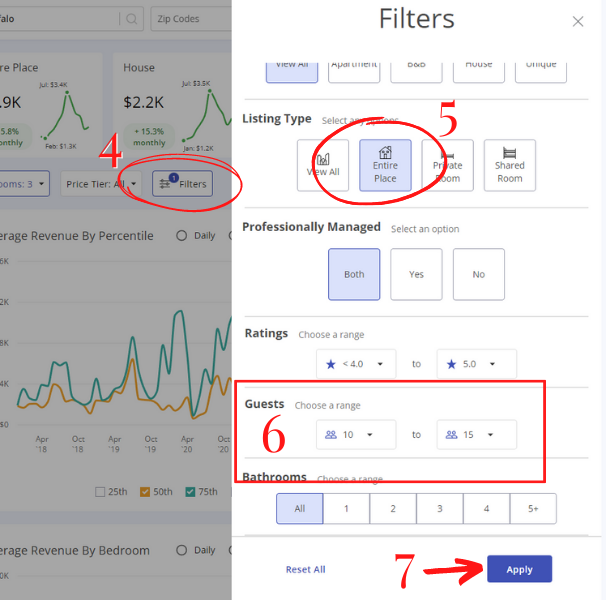
16. Get “best case” revenue numbers.
When you’re exporting from the previous step, you’ll get a CSV file, often with both the 50th and 75th percentiles included. Depending on the source, your results will go back multiple years.
It does not choose a property and place each of its month’s revenues into one column. Instead, it collects all revenues, and places them in a percentile each month. So in the export, a property that was in the 90th in January might be in the 50th in February.
This is why the 90th percentile column and the “Top Performers” section might not exactly match, and why it can be helpful to verify both ways.
Anyway, the 50th percentile numbers are exact median performers.
The 75th percentile, or top 25%, is often what we actually aim for as investors. While it’s what we expect, often we can outperform this number. But we won’t worry about anything but the 50th and 75th during this step.
Because COVID was such a shake-up for many markets, we want to carefully see how COVID affected the revenues.
Sometimes what we see is a big increase with it “settling” back into where it would’ve been during normal growth. Pay attention to this.
Sometimes it was flat growth and COVID increased revenues. If we consider this revenue and it goes back to pre-COVID revenues, you might not be able to cover your carrying costs.
I believe this is what’s led to the 2022 and 2023 #airbnbust.
Because we have to use annual revenues, the popular real estate 1% rule equates to a max purchase price of 8.3x annual revenues.
However, with short term rentals, you’re paying for all carrying costs including utilities. So we can use 1.5% (max purchase price = annual revenue * 5.6) or even 2% (4.2x) if we’re only looking for “unicorn” properties.
But choose the right ‘worst case’ and ‘expected’ revenues to get the best idea moving forward. Then, write them down.
17. Absolute dollar amounts.
This one will vary from investor to investor. But the idea relates to the revenue.
Say you use cash-on-cash as your main metric like I do. And you find a property that is priced low and earns a low revenue. But the ROI says 20%.
Amazing! Right?
Well, if 20% means the total revenue is only actually $25k, that might not be so good. For all that time and effort, you won’t be left with much in your pocket.
I can’t say there’s a definite revenue minimum here, but it’s something to think about and note on your sheet.
How To Decide: Picking the Best Short Term Rental Market
As you go through each step, you could run into a market that just won’t work.
If you’re left with one market that passes the required criteria above, go for it!
If you have two or more remaining, consider your goals and your criteria. Figure out what’s necessary for you.
If you find that three bedroom homes are in the $700’s but you’re only pre-approved for $400k, it doesn’t matter how great the market is. You can’t afford it. (Unless you wanted to try a joint venture.)
Some variables, like seasonality, are just good-to-knows and shouldn’t be a deal breaker for a market.
But different variables will weigh differently depending on your goals.
If you’re a hardcore investor, the return on investment could be THE thing you care about.
Maybe it’s a lifestyle investment for you, and figuring out why you like it is most important.
Or if you’re extra cautious, figuring out some safety nets like making sure plenty of things draw people there and it’s near a city hub might be important.
Conclusion
These steps are designed to test for STR-friendly regulations, affordability, profit, and general town research to filter down THE best Airbnb markets.
Not following all of these steps is what’s getting everyone in trouble right now.
Avoid your own AirbnBust. Thoroughly check your market before investing.

